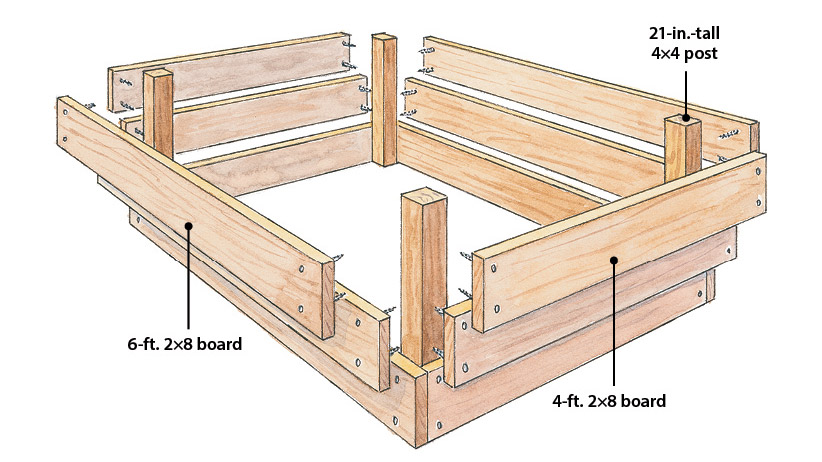Introduction
Building a wood raised garden bed is a practical and rewarding way to enhance your gardening space. Raised beds improve soil drainage, reduce weeds, and make gardening more accessible. Whether you’re a beginner or an experienced gardener, constructing a wooden raised bed allows you to tailor the size, shape, and soil quality to your needs.
In this guide, we’ll explore everything you need to know to build a durable, attractive wood raised garden bed. From selecting the right wood to assembling and maintaining your bed, this article provides expert advice, actionable tips, and clear instructions to help your garden thrive.
Why Choose a Wood Raised Garden Bed?
Benefits of Raised Beds
- Improved Soil Quality: You control the soil mix, leading to better plant growth.
- Enhanced Drainage: Raised beds prevent waterlogging and root rot.
- Weed and Pest Control: Elevated beds reduce weed competition and some pests.
- Extended Growing Season: Soil warms faster in spring, allowing earlier planting.
- Accessibility: Easier to reach, especially for those with mobility challenges.
Why Wood?
Wood is a popular choice because it is:
- Affordable and Available: Common lumber types fit most budgets.
- Aesthetically Pleasing: Natural look complements outdoor spaces.
- Easy to Work With: Simple tools and techniques suffice.
Choosing the right wood and treating it properly ensures longevity and safety for your plants.
Selecting the Right Wood for Your Raised Garden Bed
Best Wood Types
- Cedar: Naturally rot-resistant and insect-repellent; lasts 10+ years.
- Redwood: Durable and resistant to decay; premium choice.
- Douglas Fir: Affordable and strong but less rot-resistant; needs treatment.
- Untreated Pine: Economical but shorter lifespan; best for temporary beds.
What to Avoid
- Treated Wood with Harmful Chemicals: Avoid wood treated with chromated copper arsenate (CCA) as it can leach toxins.
- Softwoods That Rot Quickly: Avoid woods like spruce unless properly sealed.
Wood Treatment Tips
- Use non-toxic, plant-safe sealants like linseed oil or natural wood preservatives.
- Line the interior with landscaping fabric to protect wood and soil.
Planning and Measuring Your Raised Bed
Consider Location
- Choose a sunny spot with at least 6 hours of direct sunlight daily.
- Ensure easy access to water and pathways for maintenance.
Size Guidelines
- Width: 3 to 4 feet wide to reach the center easily from all sides.
- Length: Any length, but commonly 6 to 8 feet for manageability.
- Height: 12 to 18 inches is standard; deeper beds allow root vegetables.
Tools and Materials Checklist
- Wood boards (cedar or preferred wood)
- Measuring tape
- Saw (hand or power saw)
- Drill and screws (galvanized or stainless steel)
- Carpenter’s square
- Level
- Soil and compost mix
- Landscaping fabric
Step-by-Step Guide to Building Your Wood Raised Garden Bed
1. Cut the Wood
Measure and cut the wood boards according to your desired bed dimensions. Accuracy here ensures easier assembly.
2. Assemble the Frame
- Use a carpenter’s square to align corners at right angles.
- Drill pilot holes to prevent splitting.
- Secure corners with galvanized screws for durability.
3. Prepare the Site
- Clear the ground of grass and debris.
- Level the area to prevent uneven soil settling.
4. Install the Frame
- Place the wooden frame on the prepared site.
- Optionally, dig shallow trenches for stability.
5. Line and Fill
- Attach landscaping fabric inside the bed to prevent soil contact with wood.
- Fill with a mixture of quality topsoil, compost, and organic matter.
Maintenance Tips for Longevity and Health
- Inspect wood annually for signs of rot or damage.
- Reapply natural sealants every 2–3 years.
- Refresh soil with compost each season to maintain fertility.
- Rotate crops to prevent soil depletion and pest buildup.
Expert Insights and Real-World Examples
Garden expert Dr. Linda Chalker-Scott emphasizes, “Choosing rot-resistant wood and avoiding chemical treatments is key to sustainable raised beds.” Many gardeners report that cedar beds last over a decade with minimal upkeep, making them a worthwhile investment.
Conclusion
Building a wood raised garden bed is an achievable project that offers numerous gardening benefits. By selecting the right wood, carefully planning dimensions, and following proper assembly steps, you create a durable and productive garden space. Remember to maintain your bed regularly to extend its life and support healthy plant growth.
Start your raised garden bed today and enjoy fresh, homegrown produce with less effort and more control. Your garden’s success begins with a strong foundation—quite literally!
